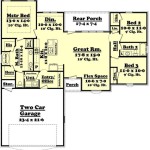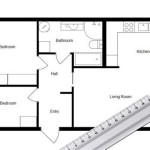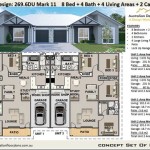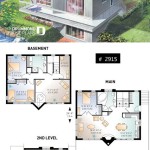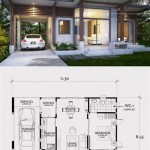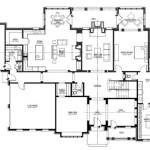How Do I Get Plans For My House?
Acquiring house plans is a fundamental step in the home building or renovation process. These plans serve as the blueprint for construction, providing detailed specifications and visual representations of the intended structure. The process of obtaining these plans can vary depending on individual needs, budget, and the complexity of the project.
The initial consideration should be the scope of the project. A minor renovation, such as remodeling a bathroom or kitchen, may require less extensive plans compared to building a new house from the ground up or undertaking a major addition. Understanding the project scope will help determine the type of plans needed and the resources required to obtain them.
Utilizing Stock House Plans
One of the most accessible methods for obtaining house plans is through purchasing stock or pre-designed plans. These plans are readily available from various online retailers, architecture firms, and home design companies. Stock plans often come in a variety of styles, sizes, and layouts, catering to different preferences and budgetary constraints. These plans are generally more affordable than custom-designed plans, as the design work has already been completed.
When selecting stock plans, it is crucial to carefully review the details and specifications to ensure they meet specific needs and local building codes. Consider factors such as the size of the lot, the desired square footage, the number of bedrooms and bathrooms, and the overall architectural style. Many stock plan providers offer modification services, allowing buyers to customize the plans to better suit their requirements. However, it is important to note that modifications can add to the overall cost.
Before purchasing stock plans, it is advisable to consult with a local builder or contractor to assess their suitability for the intended location and to ensure they comply with local regulations. Certain jurisdictions may have specific requirements regarding setbacks, easements, and other zoning restrictions that could impact the feasibility of the chosen plan.
Advantages of using stock plans include their relative affordability and readily available nature. Drawbacks can include the potential need for modifications, which can add to the cost and time involved, and the possibility that the plans may not perfectly align with individual preferences or site conditions.
Engaging an Architect or Residential Designer
For those seeking a more personalized and customized approach, engaging an architect or residential designer is a viable option. Architects possess the training and expertise to design homes that are not only aesthetically pleasing but also structurally sound, energy-efficient, and compliant with all applicable codes and regulations. Residential designers, while not necessarily licensed architects, typically have extensive experience in home design and can provide similar services, often at a lower cost. The choice between an architect and a residential designer depends on the complexity of the project and the level of customization required.
The process of working with an architect or residential designer typically begins with a consultation to discuss the client's needs, preferences, and budget. The architect or designer will then develop preliminary designs, taking into account factors such as site conditions, zoning regulations, and the client's lifestyle. These preliminary designs are typically presented in the form of sketches, renderings, and floor plans. The client will have the opportunity to provide feedback and request revisions until a final design is approved.
Once the final design is approved, the architect or designer will prepare detailed construction documents, including floor plans, elevations, sections, and specifications. These documents provide all the information necessary for a builder to accurately construct the house. The architect or designer may also provide additional services, such as assisting with the selection of materials and finishes, obtaining building permits, and overseeing the construction process.
Engaging an architect or residential designer offers several advantages, including the ability to create a truly custom home that reflects individual tastes and lifestyles. It also ensures that the plans are structurally sound, energy-efficient, and compliant with all applicable codes and regulations. The primary drawback is the higher cost compared to purchasing stock plans.
Considering Design-Build Firms
A design-build firm offers a consolidated approach where design and construction services are handled by a single entity. This integrated model can streamline the process, potentially reducing communication breakdowns and delays. Design-build firms typically employ both designers and builders, facilitating a seamless transition from the design phase to the construction phase. This can result in better cost control and a more efficient project timeline.
When working with a design-build firm, the client typically collaborates with the design team to develop the plans and specifications for the house. The construction team provides input during the design phase to ensure that the plans are practical and cost-effective to build. This collaborative approach can lead to innovative solutions and a more cohesive final product. However, it is crucial to carefully vet design-build firms to ensure they have the necessary expertise and experience to handle the project successfully.
The advantage of using a design-build firm is the streamlined process and the potential for better cost control. The disadvantage is that the client may relinquish some control over the design process, as the design and construction teams work together to find the most efficient and cost-effective solutions.
Regardless of the chosen method, it is imperative to verify that the house plans comply with all applicable local building codes and zoning regulations. Failure to do so could result in costly delays, fines, or even the requirement to demolish non-compliant structures. Consulting with local building officials or a qualified professional is highly recommended to ensure compliance.
Building codes are sets of regulations that specify minimum standards for the design, construction, and maintenance of buildings. These codes are typically adopted and enforced by local governments, and they are designed to protect the health, safety, and welfare of the public. Zoning regulations dictate how land can be used and developed within specific areas. These regulations may specify minimum lot sizes, setbacks, height restrictions, and other requirements.
Obtaining the necessary building permits is another crucial step in the process. Building permits are required for most construction projects, including new construction, additions, and renovations. The permit application process typically involves submitting detailed plans and specifications to the local building department for review. The building department will ensure that the plans comply with all applicable codes and regulations before issuing a permit.
The cost of obtaining house plans can vary widely depending on the chosen method and the complexity of the project. Stock plans typically range in price from a few hundred to a few thousand dollars. Engaging an architect or residential designer can cost significantly more, with fees typically based on a percentage of the total construction cost. Design-build firms may offer different pricing models, such as fixed-price contracts or cost-plus contracts.
It is also important to factor in the cost of modifications to stock plans or the additional services provided by architects or residential designers, such as assisting with the selection of materials and finishes or overseeing the construction process. Obtaining building permits also involves fees, which can vary depending on the scope of the project and the location.
Ultimately, the decision of how to obtain house plans is a personal one that depends on individual needs, budget, and preferences. Carefully weighing the pros and cons of each method and consulting with qualified professionals is essential to making an informed decision.
The choice of method also influences the level of involvement the homeowner has in the design process. Selecting stock plans necessitates a greater degree of adaptability and willingness to compromise, as the homeowner must work within the constraints of the pre-designed layout. Conversely, hiring an architect or residential designer allows for a higher degree of customization and collaboration, allowing the homeowner to actively participate in shaping the design of their home.
Beyond cost and customization, consider the long-term implications of the house plans. Properly designed plans can contribute to the energy efficiency, durability, and overall value of the home. Investment in quality plans can save money in the long run through reduced energy consumption, lower maintenance costs, and increased resale value.

Where You Can Buy House Plans Live Home 3d
How To Find Floor Plans Or Blueprints For My House It S In And 30 Years Old Is There Someone Who Could Draw Me The If Originals Are Impossible

How To Find The Original Floor Plans For Your House

How To Find Building Plans For My House Architecture Design Plan

9 Ways To Find Floor Plans Of An Existing House Archid

Create Professional 2d And 3d Floor Plans

House Plans And Design

Pin Page

Design Your Own House Floor Plans Roomsketcher

Cur And Future House Floor Plans But I Could Use Your Input Addicted 2 Decorating

